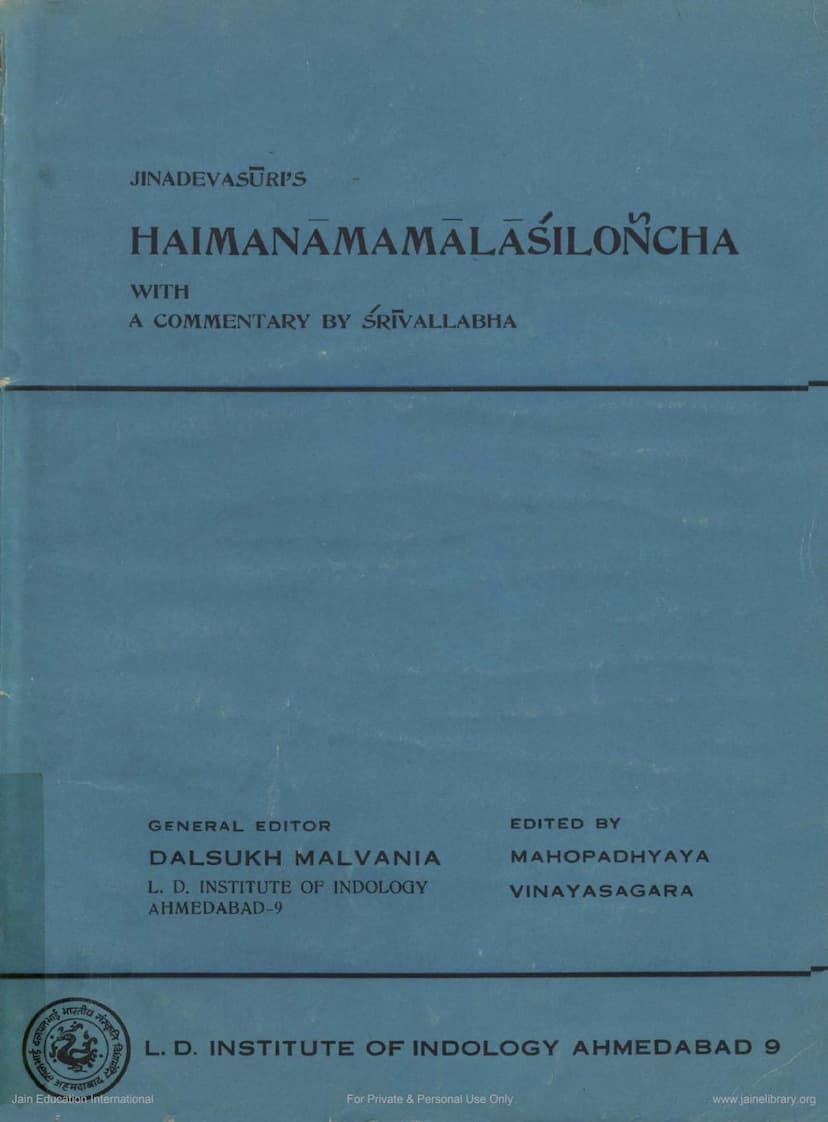Haimanamamalasiloncha
Added to library: September 1, 2025

Summary
This comprehensive summary covers the Jain text "Haimanamamalasiloncha" by Jinadevasuri, with a commentary by Vinayasagar, as published by the L. D. Institute of Indology, Ahmedabad.
Book Title: Haimanamamalasiloncha Author: Jinadevasuri Commentary: Vinayasagar Publisher: L. D. Institute of Indology, Ahmedabad Series: L. D. Series 46 First Edition: November, 1974
Core Content:
The book presents the Haimanamamalasiloncha, a supplement to Ācārya Hemacandra's renowned lexicon, the Abhidhāna-cintāmaṇi-nāmamālā. Jinadevasuri, a prominent Jain scholar from the Laghukharataragaccha lineage (V. S. 1450), compiled this work, consisting of 139 Sanskrit verses, to include words that were either omitted or newly discovered after Hemacandra's compilation. The title "Śiloñcha" (meaning "gleaning" or "collecting scattered grains") aptly reflects its purpose of gathering supplementary vocabulary.
The volume also includes the Dipikā, a detailed commentary on the Haimanamamalasiloncha, authored by Śrīvallabha Gani of the Kharataragaccha (V. S. 1625). This is the first publication of the Dipikā.
Key Features and Significance:
- Lexicographical Value: The Haimanamamalasiloncha is a valuable contribution to Sanskrit lexicography, expanding upon the foundational work of Hemacandra. It aims to provide a more complete vocabulary for literary and scholarly purposes.
- Critical Edition: The text of the Śiloñcha in this volume has been critically edited based on three old manuscripts, with variants noted in an appendix. This ensures a more accurate and reliable representation of the original text.
- First Publication of Commentary: The Dipikā by Śrīvallabha Gani is published here for the first time, offering scholarly insights and explanations of the Śiloñcha. The editor utilized three old manuscripts for its preparation.
- Biographical and Historical Context: The introduction, written by the editor Mahopadhyaya Vinayasagara, provides detailed accounts of the lives and works of both Jinadevasuri and Śrīvallabha. It highlights Śrīvallabha's intellectual prowess, his title of "Vādi" (debater), and his unique act of composing a major poem (mahākāvya) on Ācārya Vijayadevasuri of the Tapagaccha, despite belonging to a different sect.
- Appendices: The edition is enhanced by four appendices:
- Index of Words: An index of words found in the Dipikā, with words unique to the commentary marked.
- Quotations: An alphabetical list of quotations appearing in the Dipikā.
- Works and Authors: A list of titles of works and names of authors mentioned in the Dipikā.
- Variants: A record of textual variants from the manuscripts of the Śiloñcha.
- Scholarly Authorship: Jinadevasuri was a distinguished scholar of the Laghukharataragaccha, a branch of the prominent Kharataragaccha. Śrīvallabha Gani was a disciple of Jnana Vimalopadhyaya and a significant figure in the Kharataragaccha scholarly tradition, known for his extensive commentaries and original works.
Content of the Commentary (Dipika):
The Dipikā meticulously analyzes each word in the Śiloñcha, providing its etymology, grammatical gender (linga), and usage. It frequently draws upon and cites a vast array of Sanskrit grammatical treatises, lexicons, and other scholarly works (estimated to be around 170). A notable feature is Śrīvallabha's extensive use of Rajasthani dialect words within his Sanskrit explanations, suggesting his deep connection with the region.
Structure of the Work:
The Haimanamamalasiloncha is divided into six sections (kāṇḍas), mirroring the structure of Hemacandra's lexicon. The Dipikā systematically comments on the verses within each section. The publication includes introductory materials, the critically edited Śiloñcha, the Dipikā, the appendices, and a concluding inscription (praśasti) by the commentator.
In essence, the Haimanamamalasiloncha along with its Dipikā is a scholarly work of significant value for the study of Jain literature, Sanskrit lexicography, and the intellectual history of the Kharataragaccha tradition.